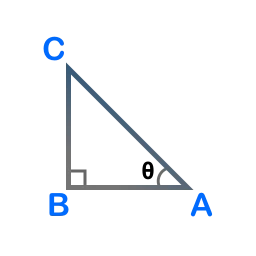tan Calculator
θ angle
tan(θ)
Calculating Tangent of an Angle
The tangent (tan) of an angle in a right-angled triangle is a trigonometric function that represents the ratio of the length of the side opposite the angle to the side adjacent to the angle. The tangent function is commonly used to determine unknown side lengths or angles in right triangles.
The tangent of an angle \( \theta \) is defined as:
\( \tan(\theta) = \dfrac{\text{length of the side opposite}}{\text{length of the side adjacent}} \)
where:
- opposite side is the side opposite to angle \( \theta \).
- adjacent side is the side next to angle \( \theta \), excluding the hypotenuse.
Consider the following triangle ABC, right-angled at vertex B.

For the angle \( \theta \) at vertex A:
- Opposite side = BC
- Adjacent side = AB
Therefore,
\( \tan(\theta) = \dfrac{\text{length of side BC}}{\text{length of side AB}} \)
Examples
The following examples demonstrate how to use the tangent of an angle to find the length of the side opposite or the side adjacent in various practical situations.
1. What is the tangent of an angle θ if the length of the side opposite is 3 units and the length of the side adjacent is 4 units?
Answer
Given:
- Length of the side opposite = 3 units
- Length of the side adjacent = 4 units
The formula to calculate the tangent of an angle θ is:
\( \tan(\theta) = \dfrac{\text{length of the side opposite}}{\text{length of the side adjacent}} \)
Substitute the given values into the formula:
\( \tan(\theta) = \dfrac{3}{4} \)
Simplify the expression:
\( \tan(\theta) = 0.75 \)
∴ tan(θ) = 0.75
2. You are standing 50 meters away from a flagpole. If the angle of elevation to the top of the flagpole is 45°, how tall is the flagpole?
Answer
Given:
- Distance from the flagpole (adjacent side) = 50 meters
- Angle of elevation θ = 45°
Using the tangent function to find the height of the flagpole (opposite side):
\( \tan(45°) = \dfrac{\text{height}}{50} \)
Simplify the expression:
\( 1 = \dfrac{\text{height}}{50} \)
Now solve for the height:
\( \text{Height} = 1 \times 50 = 50 \text{ meters} \)
∴ The flagpole is 50 meters tall.
3. A slope is inclined at a 30° angle to the horizontal ground. If the horizontal distance from the base of the slope to the point directly below the top is 20 meters, what is the vertical height of the slope?
Answer
Given:
- Horizontal distance (adjacent side) = 20 meters
- Angle of the slope with the horizontal θ = 30°
Using the tangent function to find the vertical height of the slope (opposite side):
\( \tan(30°) = \dfrac{\text{height}}{20} \)
Simplify the expression:
\( 0.577 = \dfrac{\text{height}}{20} \)
Now solve for the height:
\( \text{Height} = 0.577 \times 20 = 11.54 \text{ meters} \)
∴ The vertical height of the slope is 11.54 meters.
4. A ladder leans against a building, forming an angle of 60° with the ground. If the height at which the ladder touches the building is 10 meters, what is the horizontal distance between the base of the ladder and the building?
Answer
Given:
- Height at which the ladder touches the building (opposite side) = 10 meters
- Angle with the ground θ = 60°
Using the tangent function to find the horizontal distance from the base of the ladder to the building (adjacent side):
\( \tan(60°) = \dfrac{10}{\text{horizontal distance}} \)
Simplify the expression:
\( 1.732 = \dfrac{10}{\text{horizontal distance}} \)
Now solve for the horizontal distance:
\( \text{Horizontal distance} = \dfrac{10}{1.732} \approx 5.78 \text{ meters} \)
∴ The base of the ladder is approximately 5.78 meters from the building.